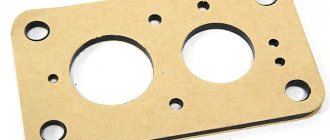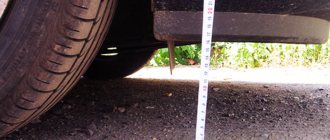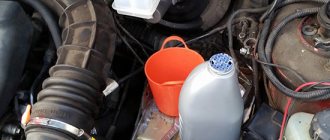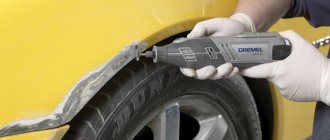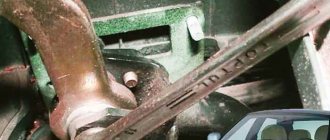It's no secret that every day a car is exposed to aggressive environmental influences. Therefore, in order to maintain the excellent appearance of the car, you need to take care of protecting its body, including the paintwork.
Hard wax based products can help with this. The effect of applying hard wax is as follows:
— the paint does not fade under the influence of ultraviolet rays; — the appearance of bitumen stains on the body is excluded; — the paintwork does not deteriorate when interacting with reagents, salts, or during winter.
Hard wax application technology
You can do this kind of processing yourself, without special skills. The essence of the work is to perform successive steps:
- Wash the car well. — Wait until it dries. — Remove bitumen stains from the body. For this procedure you will need a napkin and acetone. — Degrease the body. We strongly recommend that you do not skip this step! — Apply hard wax to the car body. Movements during work should be smooth, circular. — Leave the wax to dry for about 10 minutes. — All that remains is to polish the surface using microfiber.
What was achieved after applying hard wax?
1. The body began to shine like new. 2. Small scratches have become invisible, hidden under a layer of wax. 3. The car gets dirty less, as water and dirt roll off the polished surface.
To maintain the effect, it is recommended to apply wax once every 2 months.
Car wax
Why is processing needed?
The idea of using wax to treat car bodywork is not new. The product hides chips and small scratches. It prevents corrosion, since moisture does not reach the treated metal. When rubbed, the substance heats up, its particles become more liquid, acquire the ability to penetrate into small cracks, filling them when hardening. The surface becomes smooth and the shine of the paintwork returns.
Paraffin, which is part of the wax, reliably protects against moisture and repels it at the molecular level. A hydrophobic film, invisible to the eye, appears on the body. It is able to protect against precipitation, chemicals used in various products for cars, washing roads, and clearing them of snow. The car becomes easier to wash, and it needs to be done much less often.
Benefits of using wax
Waxing your car after washing is beneficial. This has the following advantages:
- The surface is reliably protected by the formed film. The treated coating repels moisture and aggressive substances, and makes it easy to wash off insects, tree resin, and other natural components that are usually difficult to clean from the car body.
- Modern waxes and sealants protect paint from fading: they are able to reflect ultraviolet rays.
- The treatment helps get rid of minor scratches and make the appearance of the car more attractive. However, the substance will not get rid of large and deep damage; only abrasive polishing will help.
- The paint surface acquires additional shine, and sealants help protect it from damage.
- Synthetic sealant can retain its properties for up to two to three months, if the car is operated in a gentle mode, its body is rarely exposed to aggressive substances.
How to make:: polishing wax
Naturally, this wax is easy to buy in a specialized store. But if you have the opportunity to make your own wax, why not take advantage of it? Moreover, it will take a little time, and the price of the ingredients will be much cheaper than the finished product.
Benefits of polishing wax
Modern furniture is often made from materials that do not require wax polishing. But antique furniture and some wooden interior items without waxing lose their attractive appearance. After polishing, the wood literally comes to life, returning its lost color and shine.
Why wax? Wax contains three large groups of substances: esters, free fatty acids and carbohydrates. Wax oxidizes very slowly, so much so that oxidation can be neglected. Under certain favorable conditions, wax retains its properties for centuries, or even millennia. Due to the viscous nature of the material, the boiling point of beeswax is higher than that of any other wax. Beeswax is absolutely impervious to moisture, but interacts well with solvent, which makes wax the best base for making an emulsion. Polishing wax gives the treated wood a silky and soft shine.
In addition, beeswax and an emulsion based on it can be an excellent alternative to many varnishes that contain harmful chemicals and have a persistent unpleasant odor that remains in the room for a long time, even after the varnish has dried. But a polishing mixture based on beeswax, on the contrary, is absolutely environmentally friendly, has no pungent odor and is quite resistant to external influences after application to a wooden surface.
Making a polishing mixture
There are several recipes for polishing mixtures. Everywhere the main ingredient is beeswax. Depending on the proportions of the components taken, the mixture can be liquid, paste or solid. More precisely, the thickness of the mixture depends on the amount of solvent used: the more solvent, the more liquid the mixture turns out.
Traditional polishing compound
Ingredients:
1). Beeswax. You can buy it in a specialized store, or even better, buy it directly from a beekeeper, it will cost less, and you will definitely get a high-quality product.
2). Turpentine. Typically, turpentine is taken in the same quantities as wax, in a 1:1 ratio.
Making the mixture
1. The wax must be crumbled into pieces and melted, either in a water bath or in the microwave.
2. Slowly and carefully begin to pour turpentine into the hot wax, stirring continuously.
3. The finished mixture is poured into a suitable container, for example, a cream jar, and left until completely hardened.
But it is often recommended to replace turpentine with another solvent. Although turpentine is an organic product, it is also a dangerous chemical that can cause eye irritation, skin irritation, and damage to the lungs and central nervous system (if turpentine fumes are inhaled). But this in no way applies to a ready-made turpentine-based polishing mixture; you experience a much greater risk in the process of making the mixture.
Instead of turpentine, you can use other solvents, for example, various vegetable oils. In principle, any will do. Olive oil is especially often used to prepare the polishing mixture. You won't need anything else besides oil and wax. Olive oil based polishing mixture can be used on any type of wood.
Olive oil polishing mixture
Ingredients:
1). Beeswax - 2 tablespoons.
2). Olive oil - 6-8 tablespoons.
Chop the wax into small pieces and mix with olive oil. Melt the wax mixed with oil in a water bath or in the microwave. If desired, you can add suitable extracts to the melted wax, but this is at your discretion and is not at all necessary. We also pour the finished mixture into suitable containers and leave to cool.
Polishing mixture with jojoba oil
This oil-safe polishing wax is great for polishing children's wooden furniture and toys that your child might put in their mouth. The mixture is absolutely safe in composition even for the smallest children and does not cause allergies.
Ingredients:
1). Beeswax - 50 milligrams.
2). Jojoba oil - 150 milliliters.
3). If desired, you can add extracts and vitamin E.
Ratio: 1 part wax - 3 parts jojoba oil. Melt the wax in a water bath and add oil. Mix everything thoroughly, pour into containers and let cool. The ratio of oil to wax can be changed depending on the consistency of the mixture you plan to obtain.
Some useful information
-The wax-based polishing mixture is ready for use even when it has not yet hardened.
-The olive oil mixture can be stored for 1 year in a closed package in a cool place and out of direct sunlight.
-The mixture with jojoba oil can be stored for up to two years under the same conditions as the product with olive oil.
-Warm mixture is best used for insulating purposes. At the same time, a cooled mixture is better suited for polishing.
-Liquid polishing wax can be applied with a wide brush, but more often it is done with a cloth.
-Polishing wax is able to restore the original color of old wood, eliminates scuffs, and gives new things a darker, deeper and richer color.
Furniture polishing wax made from beeswax is a useful household item. It's worth taking note of the recipe.
Photo: vashconsultant.com, mebeledel.ru, sovetov-dom.ru, woodperfect.ru, isentsov.blogspot.com
www.ikirov.ru
Types of body wax
The least commonly used wax is in spray form. It is convenient to apply, but it has low resistance to weather conditions and is quickly washed off. The liquid version is not so convenient to use, but it is more resistant to external influences and lasts longer. The substance is applied to a dry, clean surface by rubbing. The hard type is also applied in dry conditions. This is a rather complicated and time-consuming procedure. The coating lasts from one to three months, depending on how the car is used.
Natural and synthetic products are available for sale. Polish of synthetic origin is resistant to external influences, can maintain the effect for up to 6 months, and is usually sold in liquid form. Sometimes the substance is added to car shampoos, since it can be applied to a wet surface.
Product classification according to application technology:
- Cold wax is available in liquid form. The composition includes cationic active substances and emulsion wax. The coating can be applied manually. It will need to be updated after every wash or after the car gets exposed to rain.
- Hot wax comes in the form of a fat-like substance and can be natural or artificial. The coating melts at 90 °C. The highest quality is carnauba wax. It is resistant to wear, has a high melting point, and is transparent. The substance can stay on the body for up to six months and does not require renewal after washing. Many companies produce products that include corrosion inhibitors. Hot wax is harmless to a car; processing with it is safe for polished surfaces. It’s easy to understand how to apply cold wax, but with hot wax there may be some difficulties. Application occurs after diluting the substance with heated water. Then it is distributed over the body of the machine using a sponge. The downside is the high price.
- The third type is foam wax. Its difference from other materials is its special application technology. Special equipment is required that can direct foam under pressure. Such equipment is usually available only at sinks, so this type is most often not used at home. Polishing occurs by creating a foam emulsion. The equipment pumps air, mixes it with water and wax, and shoots it onto the car body. Thanks to high pressure, polishing occurs when the emulsion and the surface of the car collide.
Other classification of substance:
- synthetic;
- natural;
- animal origin (bee);
- of plant origin.
When choosing a product, it is not necessary to pay attention to the production method, since all waxes, regardless of origin, have similar properties and characteristics.
Which wax is best to use for processing?
The first wax materials for car body treatment were liquid or solid; progress does not stand still; as a result, synthetic and spray-type materials appeared. But still, the latter is not so good in terms of efficiency. Wax spray is considered the worst, since its protective properties are enough for two or three washes, which means you will have to apply and buy it much more often. Compared to other types of materials, the spray is applied easily and quickly; within 15-30 minutes the entire car body can be treated.
Liquid wax or in paste form is more resistant to detergents and external factors. It is better to treat the body with liquid wax on a washed surface, followed by rubbing in order to apply it as much as possible to damaged areas and microcracks. Hard wax is considered the best, but as car owners who have had to use it note, it is the most labor-intensive among all possible methods of protecting a paint surface.
You need to apply hard wax to a dry surface, the work takes quite a lot of time, and if you also take into account hot weather and direct sunlight is better, it can take the whole day. The protective effect of such a wax film lasts quite a long time, about 3-4 months, with good resistance to rough environmental factors (dirt, salt on the roads in winter, rain, snow and frost). Synthetic is considered the most durable; it is the most resistant to external factors and is able to retain its properties for six months. In addition to products used to treat car bodies, synthetic wax is added to car shampoos.
In addition to classifying wax by properties, it is divided by type of application. Cold types of application include compositions that include active cationic substances and emulsion wax in sufficiently large quantities. As a rule, such wax is applied manually. The main disadvantage of this type is its fragility; often after each wash it is necessary to reapply a layer of wax.
The second type of wax for car body treatment is hot. According to the type of base material, the main part is fat-like or synthetic in origin. According to experts, carnauba wax is recognized as the highest quality. To treat a car body with this wax, you need to heat it up to 90 degrees Celsius. It is almost impossible to carry out such a procedure at home, since the product hardens almost instantly after heating. The cost of the material is also not cheap, but the resulting film retains its properties for up to a year.
The latest type of wax using foam application technology. This wax contains the same substances as for hot application, but the application technology itself is completely different. This will require special equipment capable of creating a special foam, or rather its emulsion, by mixing air, a special composition and water. Due to the pressure under which the foam is applied to the surface, this method obtained the best results in adhesion and application. Polishing applied foam is much easier than hot wax.
When choosing wax to treat a car body, you need to consider its origin. Leading manufacturers divide it into four main types - plant, mineral, animal and synthetic. Considering that the properties of each type are almost the same, this parameter is almost not taken into account when selecting a material for processing a car body.
How to apply?
A protective layer of body polish is applied after washing the car. Each time you visit a car wash, the polish may be partially washed off. It is recommended to regularly renew the coating layer.
To keep the body clean and get rid of stuck small particles, dirt, and stains, special waxes, clays, and various chemical compounds are used. So, when using Turtle Wax 2 in 1 paste, two tasks are solved at once: the body is cleaned of adhering dirt, gets rid of drips and stains, polishes the surface, and protects it from dirt and moisture. This saves time and effort.
Protecting your new car's paintwork from chips and scratches
The car body is least protected from external influences, since when driving it gets hit by gravel and pebble fragments, small pebbles; in addition, it can be damaged by branches of trees and shrubs, fences, posts, walls, flower beds and other obstacles, as a result of contact with which scratches, chips and dents are formed.
Applying a protective film to the car will provide reliable protection of the paintwork from mechanical damage.
One of the most effective means of protection is polyurethane film, which has many obvious advantages that have made it in demand by car owners all over the world. So:
- it will not turn yellow from exposure to road reagents, as well as ultraviolet rays;
- it is not negatively affected by significant temperature changes;
- it is distinguished by elasticity and a high degree of strength;
- it is easy to polish and wash.
In addition, such a protective coating has other advantages. So, if small scratches appear as a result of wiping the surface with a dirty rag, they can be easily removed. To do this, you need to soak a clean microfiber in hot water and wipe the damaged areas with it. As a result, the film will heat up and, thanks to its elasticity, smooth out, tightening the damaged fragments.
The film is not afraid of certain types of chemical exposure (for example, solvents often used by road workers when marking roads and repairing bridges, as well as by workers of housing and communal services enterprises when painting objects).
When the film is applied correctly to the surface of the car body, it is absolutely invisible. The Suntek coating is so transparent and smooth that once applied, the car has a spectacular shine that adds gloss to its appearance.
With proper pasting and proper use, such a film will last at least ten years. That is, during this period you can forget about additional protective measures, as well as the costs of body repairs.
Due to the absence of an ultraviolet filter on this material, the car’s paintwork fades evenly and regardless of how the car is covered (in whole or in part), so there will be no differences in color between places covered and not covered with film.
Composition and application
The polish will protect the car from the accumulation of dust, dirt and the possibility of rust, as it repels water.
Before preparing a polish, you should determine for what purpose it will be used. The presence of an abrasive substance in the composition depends on this.
Polish is divided into:
1. The abrasive is produced by burning chromium-containing paint or ammonium dichromate.
If ammonium dichromate is chosen as an abrasive, then its preparation will take place in two stages:
2. The binder composition is prepared from the following components:
3. There are other recipes for making car polish. They are made from clay or beeswax.
The wax product is made with the addition of turpentine or vegetable oil. The oil component is combined with the same volume of hot wax and mixed.
To work with all of the listed substances, you will need gloves and a mask or respirator.
In order to cover a car with polish, you will need sponges and microfiber rags. A polishing machine will save time and effort when applying the composition.
There is a certain procedure for applying polish to a car. After a motorist has learned how to make car polish himself, he should familiarize himself with the rules for applying it:
1. First of all, the car must be washed and completely dried.
2. All polishing work should be carried out in a well-ventilated area, or outdoors under a canopy in calm weather.
3. The air temperature should not be below 10 and above 30 degrees.
4. Direct sunlight should be avoided so that the machine body does not heat up.
5. It is recommended to degrease the surface with a special compound.
6. The entire area of the body must be divided into equal sections and processed each in turn.
7. The polish is applied for 15 minutes to be absorbed, and then the cars need to be polished.
8. The polishing machine is only suitable for large surfaces.
9. Difficult areas are best treated with felt or microfiber.
10. The completion of the work will be the application of a fixative, which will give the car a special shine.
The car's headlights also need to be polished. At home, regular toothpaste will help with this. The paste must be applied to the headlight and rubbed - these steps can be repeated several times and the paste can be washed off with water.
11. Based on the above, it becomes clear that preparing a polishing composition with your own hands will not take much time.
You can learn how to make car polish and apply it correctly using training videos on the Internet or from fellow motorists.
It will be useful: Lada Granta what oil to put in the box
Protective film, nanoceramics or liquid glass
Ceramic Pro 9H can be classified as a new generation of car body protection products, for this reason it is preferred by a large number of car owners.
Ceramic PRO 9H is a long-term anti-corrosion protection for car paintwork. The principle of its operation is to create a hydrophobic effect, which occurs due to a high level of surface tension, due to which the liquid rolls off the coating, picking up dirt and dust, and this allows you to wash your car less often.
In addition, Ceramic Pro is an excellent protective agent against reagents. It can also be used as anti-graffiti.
You can protect your car body from the effects of the external environment on a budget using liquid glass - an effective product used by many car owners. For example, Willson liquid glass is the number one polish today, and this is recognized by many manufacturers of similar products.
Willson can solve numerous problems. It is especially worth noting that this coating lasts for quite a long time at an optimal price. In addition, it has many other advantages:
- the material has a high degree of strength;
- the product applied to the car can repel water and dirt;
- the coating can retain its original color and mirror shine;
- The product contains no abrasive substances.
Self-preparation technology for polishes
Before you start mastering home production, you should remember that any polishing product must contain a certain amount of an abrasive substance. Another important element is the binding component, in other words, the base, which can be either liquid or silicone.
Preparing an abrasive for cleaning the body comes down to the following steps:
- It is necessary to burn a small amount of paint (about 200 grams), but it must be chromium-containing. This can be done over a fire or using a soldering iron;
- another option is to purchase ammonium dichromate and then burn it;
- in this process, a liberation of hydrochloric acid is formed, which must be evaporated after oxidation.
Now you need to make a binding component similar to the one used in the well-known GOI paste. For this purpose, we will dilute together 2 parts of stearin, 1 part of acetic acid. Mix all this with 7 parts of chromium oxide and a couple of drops of kerosene. The resulting components will combine better if they are slightly heated during mixing.
Protection of glass and interior of a new car
To protect the car's interior from overheating, its rear, windshield, side windows and panoramic roof are tinted with a special athermal film, thanks to which the plastic and other interior elements do not fade and the leather does not crack.
Tinting with athermal film prevents UV rays from penetrating into the interior. It can be transparent or darkened.
The properties of the athermal film allow:
- increase car safety, since the film is able to retain fragments when glass breaks;
- provide comfortable conditions in the cabin, especially in the heat, since thanks to this coating the temperature decreases and the light intensity decreases;
- significantly reduce the intensity of the influence of UV rays on the interior trim, and this makes it possible to maintain its original appearance for a fairly long period of time;
- reduce the load on the air conditioner, which will help save fuel.
Thanks to this tinting, excellent light transmittance of the glass is ensured. It is for this reason that the film can be used on the rear and windshields.
Such tuning cannot raise questions among traffic police officers and will allow you to pass inspection without any problems.
The second no less significant way to protect the interior from the destructive effects of heat and cold, as well as scratches, moisture and dirt, will be the use of various types of protective coatings.
Thus, the most effective means of protecting the interior from wear are Ceramic Pro Plastic and Ceramic Pro Leather coatings. After their application, an invisible thin hydrophobic layer is formed that protects the leather covering of chairs and other interior elements for a long time (at least 9 months).
After processing, the color becomes saturated, and most importantly, it does not fade for a long time under the influence of ultraviolet rays.
Ceramic Pro Leather and Ceramic Pro Plastic coatings are recommended to be applied after the interior has been dry cleaned.
To ensure that a new car retains its appearance for a long time, today car owners are offered effective means of protecting the car interior, as well as its paintwork.
These include Suntek anti-gravel film, liquid glass, Ceramic Pro coatings, including Ceramic Pro Plastic and Ceramic Pro Leather protective agents. These compositions have proven their effectiveness in practice, which is why they are used by hundreds of thousands of consumers in many countries around the world.
A car, like any thing, needs careful and competent care. However, even very experienced car owners do not always pay enough attention to the condition of the body. During operation, microcracks and chips form on the paintwork of the body, which may not be noticeable, and if this fact is left without due attention, the consequences can be quite serious. Under the influence of the external environment - rain, sunlight, road dirt with impurities of harmful reagents, microcracks will increase and corrosion may occur. In order to avoid such a situation and protect the paintwork of the body, various polishes are used, but liquid car wax can also be used effectively.
Lada Priora Universal › Logbook › Making car wax with your own hands
We all (or almost all) love it when the car looks beautiful, clean, shines in the sun and pleases the eye with a shiny paintwork without red dots or scratches.
For this, many people use so-called car waxes. The essence of the action of car wax is to create a smooth, water-repellent protective layer that fills microcracks in the paintwork. One of the very popular components in car waxes is carnauba palm wax. This is one of the hardest natural waxes in the world, and it is precisely its properties that make it possible to create a fairly reliable water-repellent surface coating. We will do it ourselves! In the last post I promised to write how to do this. Well. The boy said it, the boy did it! This is not only an inexpensive and effective means for car care, but also a wonderful gift, which, when manufactured, will cost you 30-40 rubles at cost per souvenir jar, sufficient to cover a small car. To make polishing mastic we will need simple ingredients: - carnauba wax flakes - 20 g. — beeswax — 5 gr. — coconut oil — 45 gr.
The first thing we need to do is melt the carnauba wax flakes. Melt them in a water bath! After melting, add beeswax and wait for it to melt. The result should be an amber liquid as in the photo.
Add coconut oil there, melt and mix thoroughly until you obtain a homogeneous, beautiful liquid.
Then add 10-15 cc from a syringe. natural pine turpentine (for coolness and aroma, you can use rose or other easily evaporating oil). Mix well and pour into a proprietary jar for storage. I took a jar of sushi sauce.
Use after cooling in air. Cool at room temperature. Your personal gift home made car wax is all ready! Apply to paintwork as follows: - first scoop a small amount from a jar with a napkin and rub it over an area of approximately 40x40 cm in a thin layer. - apply a layer to the next square. - polish the previous layer. - thus covering the entire surface. - polish completely. For polishing, use a special cloth (these are sold in car dealerships) or a polishing machine. Why are we doing this? — dirt and water will settle not on the paintwork but on the thinnest layer of wax. - a layer of wax will penetrate microcracks and repel water and dirt, preventing them from reaching the steel and reducing the likelihood of redness. - you can give the paintwork a beautiful shine. — the car gets dirty less, dirt and water are blown away better by the oncoming air flow. - add more.
Where else can this be applied? You can coat the boots for hiking in the forest and they will become waterproof. You can also experiment with the components, for example, slightly increase the ratio of carnauba wax (the composition will become harder, more durable and shiny on the surface, but it will become more difficult to apply).
Where can I buy these components? The components are sold in their entirety in craft stores, you can look at them on Avito. I bought a kilo of carnauba wax from St. Petersburg with courier delivery to Kirov, it turned out to be 900 rubles/kg with delivery. Beeswax is available at bee shops, and coconut oil can be purchased cheaply from nutritional supplement retailers or popcorn ingredients retailers. You can fry potatoes or scrambled eggs with the leftovers; this oil is good because it doesn’t burn out, or you can give it to women - as soon as they get access to it, they immediately begin to spread it on themselves :))
Well, in the last photo - the engine compartment lid is half covered with wax. The left is covered and the right is uncovered. It is immediately obvious that water collects in balls on the coating and does not wet the paintwork.
Source
So what is liquid car wax?
There are several types of liquid wax
The protective layer of liquid wax repels dirt particles and moisture, so the car stays clean much longer.
Liquid car wax is a special liquid product for protecting the paintwork of a car, based on synthetic or natural components. When treated with a car body composition, its components fill microcracks, small scratches, chips and other unnoticeable coating defects and prevents dirt and dust particles from penetrating into them. The wax also forms a kind of protective film that covers the entire body and repels road dirt and moisture from it, thus preventing the formation of premature corrosion. Waxing is also used to add shine to the paintwork of the body. After this procedure, the color of the coating will look brighter and it will acquire shine. The protective layer repels dirt particles and moisture, so the car stays clean much longer. In addition, the car dries much faster after washing. Treating a car with liquid wax can be done independently at home, or by professionals. Liquid glass, a modern ceramic-based protective product, has similar properties. Coating with liquid glass gives a more pronounced and long-term effect, but only professionals can perform such a procedure, and it costs several times more. But it’s up to you to decide whether liquid glass or wax is better.
How to choose wax for car body treatment
To treat the body of a car no older than five years, it is better to use liquid or solid wax. The paintwork is not yet so “tired” and the film lays down evenly. For older cars (5 years and older), it is better to use abrasive mixtures or wax-based polishes. In this case, microcracks and defects in the paintwork are better filled.
Which liquid wax is best for a car?
How to polish car windows from scratches with your own hands
Before you figure out how to use liquid wax, you need to find out what types of wax exist and how they differ. Today on the market you can find 3 types of wax from different manufacturers: Cold. The most affordable and easiest to use option. Before treating the body, you just need to dilute liquid car wax in water in accordance with the instructions and you can get to work. However, the effect of this procedure is not very durable and will need to be repeated 1-2 times a month; Hot. This type is distinguished by more expensive components that prevent the formation of corrosion. Dilute the protective liquid in hot water, strictly following the instructions. The price of hot liquid wax for cars is higher, but the effect is longer - from 6 months to a year; Foamy. This is the most expensive option. Only professionals can treat a car with foamy liquid wax, since special equipment is needed to convert the wax composition into foam. The effect of such a procedure is the most noticeable and long-term. Regardless of the type of protective liquid, the quality of the product itself is of great importance. Liquid wax "Grass" combines the highest quality and a very attractive price.
Types of wax
Today, several types of wax are known. Let's take a closer look at them.
Cold wax
Great attention should be paid to cold waxes containing surfactant particles and emulsion. When applied, this composition easily fills microcracks, various scratches and cracks in the body covering. This makes the car shine, makes washing easier, and speeds up drying.
Cold waxes have one drawback. They don't last long. In other words, to consolidate the effect of such compositions, it is advisable to use them after several washes in a row.
Hot wax
Professionals recommend paying attention to hot waxes. They are not found on sale very often, so they may not even be known to a wide number of motorists. The composition resembles a fat-like substance, which can be artificial or natural.
Hot waxes last from 6 to 12 months. They perfectly protect body surfaces. The only disadvantage is the application process, which is more time-consuming compared to the cold method. You will need to dilute the composition with hot water in the same parameters, apply with a napkin and polish.
You should know that carnauba wax is often added to hot waxes, which is characterized by absolute transparency and ultra-reliable protection. In addition, substances are added to this composition that effectively stop the effects of corrosion.
Another disadvantage of hot waxes is their price. Due to the fact that the compositions use expensive raw materials, they cost much more.
Foam wax
Foam waxes are similar to hot waxes. To apply such wax, however, you will need special equipment. The fact is that foam waxes must be applied with the support of a jet of air under pressure.
Only in this way does a wax coating of this type adhere well to a metal body and is sprayed more evenly.
Hard wax
This is a modern tool. It is distinguished by its universal properties due to the creation of a thin water-repellent film on the body, and does not require complex application technologies. It is practically no different from liquid wax. Same shine, lasting effect for 5-6 months (several procedures in a row are required).
Hard wax contains natural and synthetic substances. For example, it can be either beeswax or vegetable wax.
Watch a video on how to apply body wax
How to properly apply liquid wax to a car
Polishing a car with liquid wax
Polishing a car with your own hands is not a difficult operation, but before you understand the technology of applying liquid wax, you need to carry out a number of preparatory measures. First of all, you need to wash the car very thoroughly. Hand washing will not work in this case, so it is better to use special equipment or go to a car wash. Then you need to let the car dry quite a bit, but keep in mind the fact that the wax will stick well only to a moistened surface. While the body is drying, it is necessary to dilute the wax in water, strictly following the instructions. And prepare a napkin or sponge with which you plan to apply the coating. Now you can start applying liquid car wax to the body. Both cold and hot varieties are applied in an identical way, only the method of diluting the composition differs. It is necessary to apply the protective composition in small areas, leaving no untreated gaps or gaps. It is necessary to start processing from the roof, slowly moving towards the lower parts of the body. After the wax protective layer has covered the entire body, you need to let it “absorb” a little, that is, do not touch the car for 15 - 20 minutes. After waiting the specified time, you can begin polishing - use a soft, dry cloth to treat the entire area of the body in a circular motion. To obtain the desired effect, two essential conditions must be met:
- To ensure that the composition adheres well, avoid direct sunlight on the car;
- Avoid large temperature changes. The difference between the temperature of the body and the wax solution should be no more than 20 degrees.
Recommendations and tips
You need to work with wax correctly. If you follow the nuances of technology, the body covering will be reliably protected.
- Body surfaces must be clean not only from dirt, but also from grease.
- It is better to wash the car by hand, and then carefully check the paintwork for contamination.
- Apply wax only to a dry body surface.
- First, it is better to apply the composition to small areas of the body, and then rub it in thoroughly with a sponge or soft cloth.
After the body surface is covered with wax, the composition dries, you can start polishing. For this, a special fabric is used, for example microfiber. It is recommended to process the body in a box where it is clean and dry.
Note. It is not recommended to apply wax in windy, hot or cold weather. The temperature should be standard.
It is also recommended to pay attention to the manufacturer. It is better to immediately reject Chinese compounds, carefully pay attention to the raw materials, and so on. It's better to read the ingredients right away. So, if there is an abrasive in the wax, the product will be noticeably different. It is also better not to buy such compounds, especially for new cars. In this case, it will be better to purchase pure wax.
Note. Tip on how to check the purity of the wax: knead a little paste in your palm. If there are foreign inclusions, your fingers will feel them.
Waxing is a chance to update the appearance of your car and get reliable protection against corrosion. Don't neglect the tips above if you want to operate your machine for many years without problems.
Watch videos and photos, and also study other articles on our automotive site. Familiarize yourself with the technology and techniques of car body care. Don't forget that the car frame is the most expensive part of the car.
Forget about fines from cameras! An absolutely legal new product - Traffic Police Camera Jammer, hides your license plates from the cameras that are installed in all cities. More details at the link.
- Absolutely legal (Article 12.2);
- Hides from photo and video recording;
- Suitable for all cars;
- Works through the cigarette lighter connector;
- Does not cause interference to radios and cell phones.
How to make liquid car wax with your own hands
If for some reason you do not want to use ready-made products, you can make your own wax at home on the stove. However, keep in mind that no matter how hard you try, home preparation will be less effective. The Internet is replete with articles and video tutorials on how to make liquid wax yourself. The easiest and most affordable way is to make a homemade product based on coconut oil. In order to make a wax composition using the specified method, you will need:
What is a car wax pencil for and how to use it?
- steamer or steam bath utensils;
- the wax itself, of natural or artificial origin (vegetable, bee) – 5 grams;
- natural coconut oil – 50 grams;
- carnauba flakes – 20 grams.
At the initial stage, you need to send the carnauba flakes with wax to a steam bath to melt. When the liquid becomes homogeneous, stir in the required amount of coconut oil. After adding coconut oil, the solution must be constantly stirred until it becomes homogeneous again. When the liquid reaches a uniform consistency, it must be removed and allowed to dry. Cured wax can be used. After a few hours, the liquid will harden, in this form it is very convenient to store, and before use it is enough to simply warm it up. Making homemade wax for polishing is a complex and time-consuming process that will not give a 100% result. Yes, and to prepare a decent product you need to get your hands on it.
We polish the car body ourselves
If for some reason a car enthusiast does not visit a professional car wash, then he can easily cope with waxing the body on his own. To do this, you need to acquire a high-quality polishing agent and some simple equipment. Since the most common polishing is carried out with short-lasting liquid wax, it should be considered in more detail.
Before using any drug, be sure to read the instructions on its packaging. Try to avoid tools that do not have explanations in a language you understand. Before polishing, you must thoroughly wash the car with running water, always using special detergents. Detergents will allow you to efficiently remove small scratches in the paintwork from hardened dirt particles.
After washing, thoroughly drying the car is mandatory. To speed up drying, do not expose the car to direct sunlight. It will be enough to treat the surface with a special microfiber cloth. It will efficiently absorb the smallest particles of moisture, which will allow you to immediately proceed to the polishing stage.
You should polish your car with wax in stages. That is, the entire body must be divided into several separate parts and processed sequentially. For example, you can treat the roof, then the hood, then one door, and so on.
To obtain the best effect from applying wax polish, it is necessary to first create the most favorable conditions. This should include placing the car in the shade so that it is not exposed to direct sunlight. Ideally, it would be if you feel some coolness when you touch the car body. These factors will ensure the best absorption of wax and the formation of an effective protective film. To apply polishing wax to the surface of the body, it is best to use a soft sponge. These can be easily purchased at special automotive stores. Often these sponges come complete with polishing material.
Some car enthusiasts practice additional protection for car windows and headlights. This is due to the fact that when wax gets on the glass, stains are formed, which then have a detrimental effect on their transparency. The glass may not need to be protected, however, after applying the polishing it will need to be thoroughly cleaned with special means. If you need to protect the glass first, then a special film is used for this, which is easily attached and also easily removed.
The wax is applied in small portions to the washcloth itself and to a separate part of the body, after which it is methodically rubbed. After application, the wax is allowed to “rest” for a few minutes. Then, using a dry cloth or towel, rub the wax in a circular motion until a glossy shiny surface is formed. If the car's paintwork is not too worn, then after proper application of wax you can see your reflection on the body.
So what is liquid car wax?
The protective layer of liquid wax repels dirt particles and moisture, so the car stays clean much longer.
Liquid car wax is a special liquid product for protecting the paintwork of a car, based on synthetic or natural components. When treated with a car body composition, its components fill microcracks, small scratches, chips and other unnoticeable coating defects and prevents dirt and dust particles from penetrating into them. The wax also forms a kind of protective film that covers the entire body and repels road dirt and moisture from it, thus preventing the formation of premature corrosion. Waxing is also used to add shine to the paintwork of the body. After this procedure, the color of the coating will look brighter and it will acquire shine. The protective layer repels dirt particles and moisture, so the car stays clean much longer. In addition, the car dries much faster after washing. Treating a car with liquid wax can be done independently at home, or by professionals. Liquid glass , a modern ceramic-based protective product, has similar properties Coating with liquid glass gives a more pronounced and long-term effect, but only professionals can perform such a procedure, and it costs several times more. But it’s up to you to decide whether liquid glass or wax is better.
Types of wax polishes
Today's market for automotive consumables and accessories offers car owners a very wide range of body care products. There are so many of these products that consumers do not have time to understand the composition and properties of the products offered on the market. Meanwhile, even such a simple product as car wax also has many types and types.
The most common misconception is caused by products that simply contain wax particles, however, they are intended for slightly different purposes. We are talking about products that are used for rough polishing of the body, which involves partial rubbing of the paintwork along with shallow scratches and other defects. These products are intended for use once a year, not more often.
If you use this product too often, you can achieve a matte effect on the body, and rub it all the way to the primer. This happens extremely rarely, but we should not forget about it.
The second type of polishes containing wax are polishes for seasonal car body care. That is, their use should be limited to just once every three months. These products contain special substances that, like the previous ones, partially “eat” the paintwork, thereby leveling it. These products also contain abrasive particles, which, with frequent use, will erase an impressive layer of paint and lead the car owner to deep disappointment.
And finally, the last type of wax preparations for car body care are liquid products that do not last long. Their use provides short-term protection of the body from external influences, which is limited to two or three car washes. Often these products are used in professional car washes to give the effect of shine and newness. Such products are washed off very quickly, but their frequent use does not harm the paintwork of the car body.
Which liquid wax is best for a car?
Before you figure out how to use liquid wax, you need to find out what types of wax exist and how they differ. Today on the market you can find 3 types of wax from different manufacturers: Cold. The most affordable and easiest to use option. Before treating the body, you just need to dilute liquid car wax in water in accordance with the instructions and you can get to work. However, the effect of this procedure is not very durable and will need to be repeated 1-2 times a month; Hot. This type is distinguished by more expensive components that prevent the formation of corrosion. Dilute the protective liquid in hot water, strictly following the instructions. The price of hot liquid wax for cars is higher, but the effect is longer - from 6 months to a year; Foamy. This is the most expensive option. Only professionals can treat a car with foamy liquid wax, since special equipment is needed to convert the wax composition into foam. The effect of such a procedure is the most noticeable and long-term. Regardless of the type of protective liquid, the quality of the product itself is of great importance. Liquid wax "Grass" combines the highest quality and a very attractive price.
Wax - extending the life of the car
The best alternative to manually waxing your car may be to contact specialized companies. Proven application technology in such enterprises guarantees the use of high-quality ingredients and high-quality coating. Washing complexes can guarantee you high-quality professional treatment of your car with high-quality compounds from well-known manufacturers. They allow processing with minimal time costs and high protective properties.
You will learn how to apply liquid wax to a car in this video:
Share your information and tips in the comments, and you can also share this interesting article with your friends on social networks!
To maintain the paint layer of a car in proper form, there are a lot of auto chemical products. A certain part of them is used to increase the attractiveness of the appearance, while other copies perform functions to protect the body. Below are the types of Car Wax materials for car paint care, as well as methods for applying them.
How to properly apply liquid wax to a car
Polishing a car with your own hands is not a difficult operation, but before you understand the technology of applying liquid wax, you need to carry out a number of preparatory measures. First of all, you need to wash the car very thoroughly. Hand washing will not work in this case, so it is better to use special equipment or go to a car wash. Then you need to let the car dry quite a bit, but keep in mind the fact that the wax will stick well only to a moistened surface. While the body is drying, it is necessary to dilute the wax in water, strictly following the instructions. And prepare a napkin or sponge with which you plan to apply the coating. Now you can start applying liquid car wax to the body. Both cold and hot varieties are applied in an identical way, only the method of diluting the composition differs. It is necessary to apply the protective composition in small areas, leaving no untreated gaps or gaps. It is necessary to start processing from the roof, slowly moving towards the lower parts of the body. After the wax protective layer has covered the entire body, you need to let it “absorb” a little, that is, do not touch the car for 15 - 20 minutes. After waiting the specified time, you can begin polishing - use a soft, dry cloth to treat the entire area of the body in a circular motion. To obtain the desired effect, two essential conditions must be met:
- To ensure that the composition adheres well, avoid direct sunlight on the car;
- Avoid large temperature changes. The difference between the temperature of the body and the wax solution should be no more than 20 degrees.
Bright shine without polishing: how to make your car shine?
A freshly washed car , coated with wax, shines and sparkles like new, as if you just recently took it from a car dealership. It's a pleasant feeling, isn't it? Even better is that the car not only radiates beauty - its body, or rather paintwork, is also protected from dirt, rain and road reagents. But are there any pitfalls when applying a wax protective layer? We turned to professionals and this is what we learned about how to apply this very wax, what this procedure will give, which wax is better to use and is there a difference between cheap and expensive formulations.
Those who wax their car after washing are doing absolutely the right thing. Thus, they give the paint a beautiful shine and “seal” it, preventing the negative influence of the environment in all its manifestations (rain, ultraviolet radiation, pollen, bird droppings, insects, snow or road salt).
How to make liquid car wax with your own hands
If for some reason you do not want to use ready-made products, you can make your own wax at home on the stove. However, keep in mind that no matter how hard you try, home preparation will be less effective. The Internet is replete with articles and video tutorials on how to make liquid wax yourself. The easiest and most affordable way is to make a homemade product based on coconut oil. In order to make a wax composition using the specified method, you will need:
What you need and how to use a wax pencil for a car can be read here
- steamer or steam bath utensils;
- the wax itself, of natural or artificial origin (vegetable, bee) – 5 grams;
- natural coconut oil – 50 grams;
- carnauba flakes – 20 grams.
At the initial stage, you need to send the carnauba flakes with wax to a steam bath to melt. When the liquid becomes homogeneous, stir in the required amount of coconut oil. After adding coconut oil, the solution must be constantly stirred until it becomes homogeneous again. When the liquid reaches a uniform consistency, it must be removed and allowed to dry. Cured wax can be used. After a few hours, the liquid will harden, in this form it is very convenient to store, and before use it is enough to simply warm it up. Making homemade wax for polishing is a complex and time-consuming process that will not give a 100% result. Yes, and to prepare a decent product you need to get your hands on it.
Preparation for coating and application instructions
To ensure uniform painting, you need to stock up on the right materials.
For high-quality painting you need:
- gloves;
- mask;
- soft sponge or microfiber cloth
The first thing you need to do before applying wax is to thoroughly wash and then rinse the surface to be treated. After complete drying, apply a special liquid wax composition.
Manufacturers offer several types of wax. On the automobile market you can purchase:
- wax in liquid form;
- pasty;
- in the form of a spray;
- protective sealants.
The first step is to wash the body, but not just with water and shampoo, but with cleansing clay. Both individual and mixed formulations can be found on sale. The easiest way is to use a spray bottle. The spray should be sprayed onto a clean body and immediately rubbed with a soft cloth. It should be applied not entirely to the entire surface, but segmented, in small areas. When using types of wax in the form of a paste or liquid, several rules must be followed.
How to apply paste and liquid:
- In the shade, out of sunlight.
- For application it is better to use a foam sponge.
- Application segments should be 20-40 cm.
- It is better to use the minimum amount of composition.
- It is advisable to pay attention to whether the composition should dry. So, some compositions are rubbed immediately after application, and some - after drying.
It happens that even after rubbing, traces of the composition remain. In this case, it is enough to put the car in direct sunlight for 10-15 minutes, but so that it does not heat up too much. After 15 minutes, the car urgently needs to be driven into the shade.
It is also advisable to ensure that the temperature outside and inside the cabin do not differ much. They should differ by no more than 20 degrees.
Clear sealants are helpful and help protect the body paint. They are made mainly from artificial components or from a mixture of both. The essence of their application is that they are distributed in a thin layer and left for 20-30 minutes. They are applied covering the entire surface. You can distribute the composition in a circle. This composition can be used to clean glass and plastic.
You can make your own wax using natural coconut oil and carnauba flakes. Melt the flakes with wax in a ladle until the mixture becomes homogeneous. When the mixture has cooled, you can use it.
